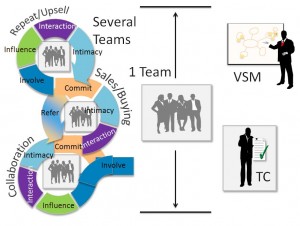What people forget about Lean is that it is the change agent for an organization. This is what attracted me to apply it in the sales and marketing arena. When we sell a product to a customer, we are often asking them to change their behavior or the way they do things. Most of us assume that when we are asking someone to change to something better (our perception) that it can be explained, and change will be implemented.
As Service Dominant Logic Thinking states: Goods are a distribution mechanism for service provision. So without the product being put to use there is no value derived. As a result, we must facilitate change within an organization to create value from our product.
I find John Kotter’s work as current and as fascinating as it was when it was first introduced to me in the 90’s. Most change methods since that time have followed a similar path, and I respect this as the “Bible of Change” I started revisiting work, though it never had left me, after interviewing Jeff Anderson, when we discussed the Lean Change Techniques he has deployed at Deloitte. You can find the interview and a link to Jeff’s work here, Lean Change Methodology.
From the New Preface to Leading Change by John Kotter:
We have learned an enormous amount in the past decade about the kinds of structures and capabilities that create a powerful enough basis to launch and sustain a big change. But among the general population of leaders and managers, the basics are still very poorly understood. Task forces, “work-streams,” and project management organizations are still the most common vehicles used to drive significant change efforts. These structures can help, but they have tendencies that can lead toward wrong processes, and they simply don’t have sufficient power for an extremely difficult set of tasks.
Kotter is also an advocate that teams are required to make change, and it is one of his Eight Step Process called Creating the Guiding Coalition. In that chapter he states:
A New Decision Making Process is required because no one individual has the information needed to make all major decisions or the time and credibility needed to convince lots of people to implement the decisions. This process must be guided by a powerful coalition that can act as a team.
Few organizations think of Sales Teams, as an effective means of delivering the needed value to the customer. The concept of teams in sales is one of the most misunderstood parts of an organization. Sales operated for so many years based on the idea of the individual salesperson calling on “his/her” accounts and the organization reinforcing this structure through individual commissions that it is very difficult to consider another way even working.
In the Marketing with Lean Book Series, I discuss in length Lean Engagement Teams and the fundamental need for that concept in today’s sales and marketing. A sample is contained in the Lean Sales and Marketing Workflow Infographic.
A description of the roles can be found in this post: Lean Sales and Marketing Roles. An overview of the Lean Sales and Marketing System:

- The Value Stream Manager (VSM) represents the product/service markets and the business.
- The Sales and Marketing Team (Team) is a cross-functional group whose number and expertise are derived from the decision making path of the customer. This Team does the actual sales; providing content, technical functions, trials, testing, etc.
- The Team Coordinator maintains the integrity of the processes through coaching and predefined control points.
If sales is about changing what a customer does, do we need Sales Teams be effective in today’s world?
